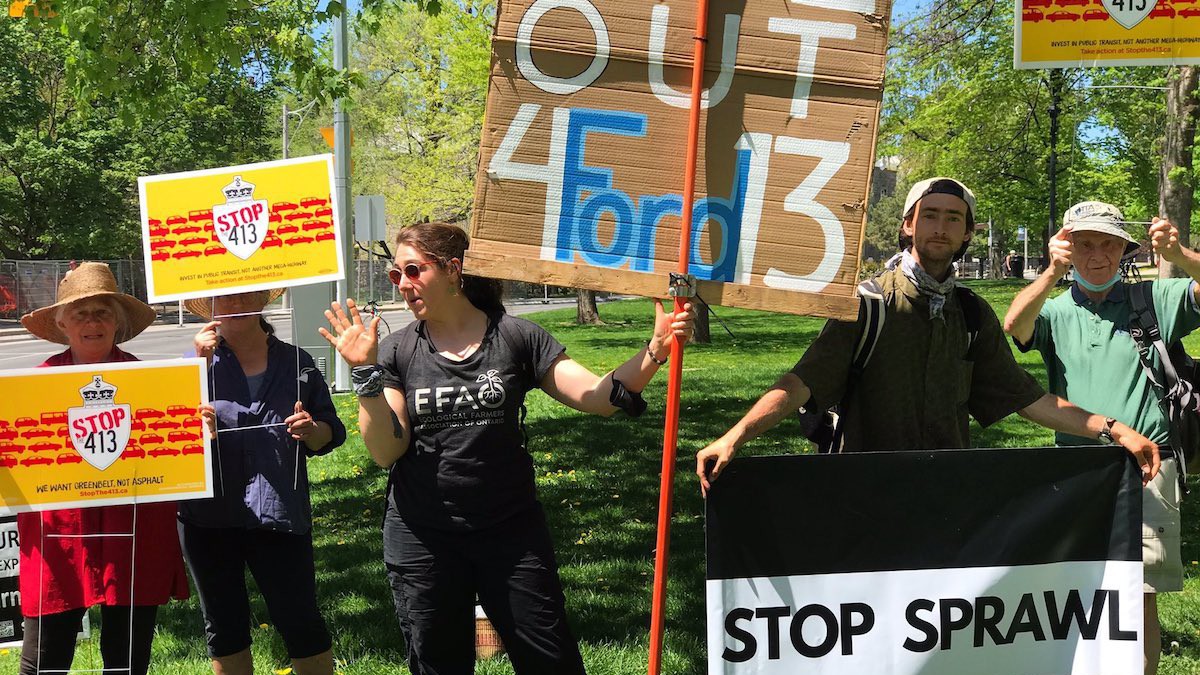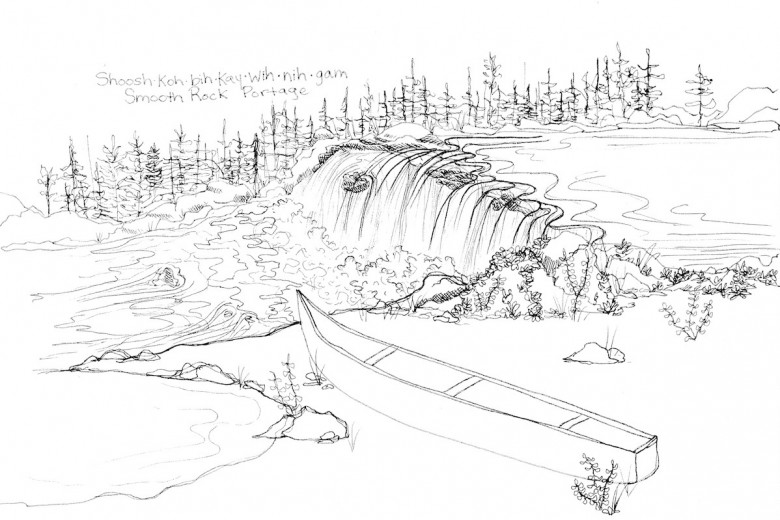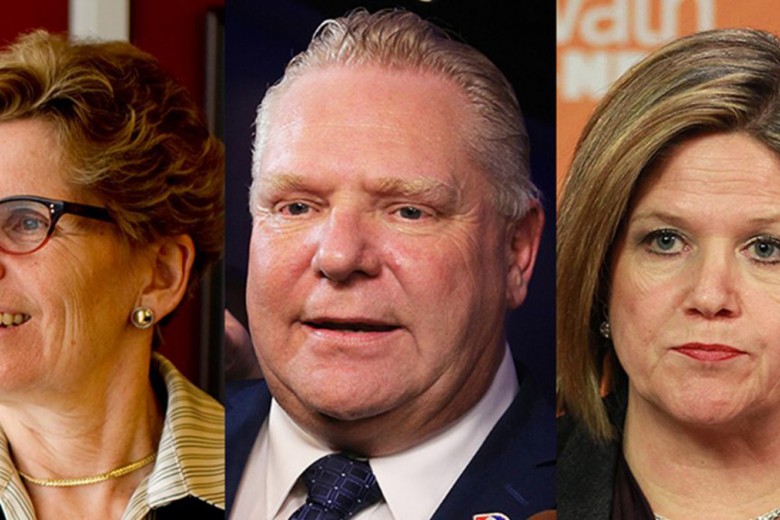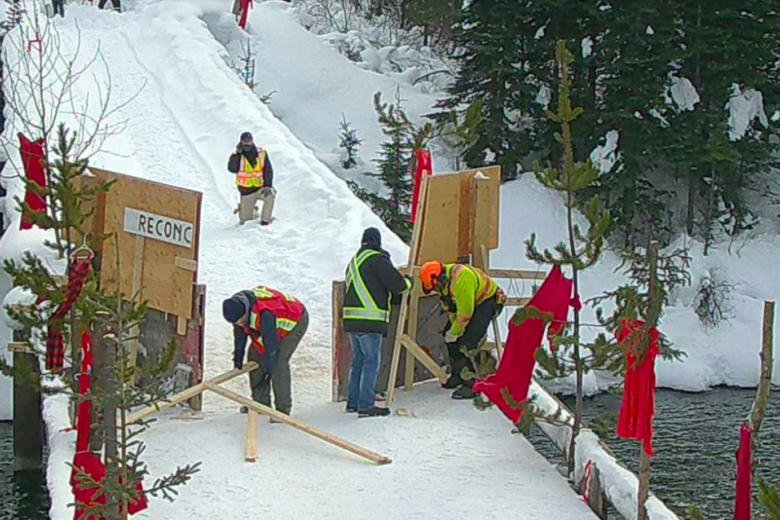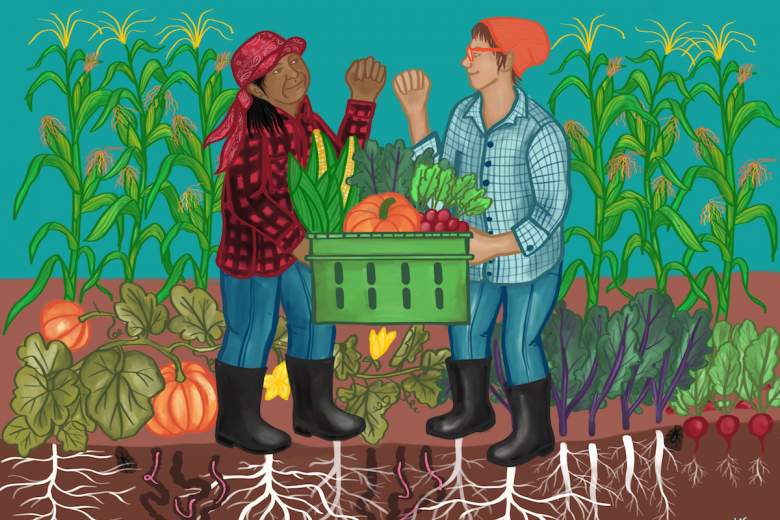One morning in the middle of a campaign period, a developer handed Jane Fogal, a municipal councillor in Halton, Ontario, an envelope stuffed with cheques.
“There it all was, 10 cheques, each from a different name,” she recalls. Each name was a different member of a family that owned a land development company – the developer’s ploy to technically comply with a law forbidding corporations from donating to municipal politicians, while still trying to purchase Fogal’s political support.
“I thought, ‘Oh my God, you can have that back,’” she says. “But that’s how it goes. I’ve seen the corruption.”
Fogal returned the cheques to the developer, but other politicians are less conscientious, accepting hefty campaign funding from land developers and then doling out favours to them.
She describes it as “the biggest land grab that I’ve ever seen. It’s only for the benefit of the land speculators, and we have to stop it.”
One of those politicians is Ontario’s premier, Doug Ford. Between 2018 and 2021, the National Observer reported, Ford’s Progressive Conservative government used ministerial zoning orders – directives that allow the Ontario municipal affairs minister to override existing planning and zoning rules, and which cannot be appealed – to push through development on areas with environmental concerns, directly benefiting developers who had together donated over $200,000 to Ford’s party and another conservative group.
And what those developers want is suburban sprawl.
In 2020, the Ford government proposed revisions to the growth plan for the Greater Golden Horseshoe region, which stretches across southern Ontario and encompasses the Greater Toronto Area. The original growth plan, created in 2006, was intended to make municipalities denser and more transit-friendly, but Ford’s changes reverse course. Anti-sprawl advocates like Fogal have called the revised plan “The Big Sprawl.” She describes it as “the biggest land grab that I’ve ever seen. It’s only for the benefit of the land speculators, and we have to stop it.”
The revised plan would destroy thousands of acres of natural areas and farmland by designating it for suburban development. It would mandate that 81 per cent of the region’s population growth through 2051 must be accommodated by building new suburban housing rather than by investing in affordable housing within already-developed areas.
The movement to stop sprawl
Since 2020, activists have built a “Stop Sprawl” coalition across the Greater Golden Horseshoe region, drawing in farmers, environmentalists, and Indigenous activists. Fogal, who spearheads the movement in Halton, a regional municipality in the western part of the Golden Horseshoe, says that 90 per cent of Hamilton residents who were surveyed are opposed to expanding the urban boundary.
She warns that giving the green light to even more sprawl would be catastrophic for the environment and for local residents. It would make the population even more car-dependent, supplanting parks with parking lots and relegating public transit and walkability to the past. It would create purely commercial landscapes dominated by big box franchises, chain restaurants, gas stations, and strip malls.
"Sprawl is also constituent of a way of life that prioritizes privatism and consumerism over engaged political participation and ecological sustainability.”
Thad Williamson, professor and author of Sprawl, Justice, and Citizenship: The Civic Costs of the American Way of Life, wrote, “Suburban sprawl as currently practiced is fundamentally hostile to the aspiration of achieving a society capable of meeting even modest norms of equal opportunity. Sprawl is also constituent of a way of life that prioritizes privatism and consumerism over engaged political participation and ecological sustainability.”
Sprawl takes money out of public coffers in urban areas – where low-income and racialized people tend to live – and moves it out to wealthy, white suburbs. In The Shape of the Suburbs: Understanding Toronto’s Sprawl, author John Sewell gives an example: as Toronto’s suburbs expanded throughout the latter half of the 20th century, the Toronto Transit Commission (TTC) decided to bring public transit service to the suburbs. But low suburban density meant low ridership numbers, and it was an expensive pursuit – one that eventually forced the TTC to raise fares and cut back on urban transit routes.
What politicians call “low-density development” requires enormous amounts of money for new roads, sewers, highways, and their subsequent maintenance. While infrastructure spending isn’t something to be avoided, sprawl is the least efficient way to manage it. Estimates by the City of Ottawa show that low-density development costs taxpayers approximately $465 per person, while higher-density development, like apartments, saves about $606 per person by making use of existing infrastructure.
This isn’t anything new – Ford has simply accelerated the trajectory toward sprawl that the governments of Ontario and Toronto started subsidizing after the First World War. In 1927, Sewell writes, the Ontario government subsidized suburban roads, paying 40 per cent of the cost to construct a road and 20 per cent of the cost to maintain it. Later, in 1965, the province announced it would begin charging less than break-even rates for water and sewer services in suburbs and in proposed suburban development sites – making suburban development even more lucrative.
Estimates by the City of Ottawa show that low-density development costs taxpayers approximately $465 per person, while higher-density development, like apartments, saves about $606 per person by making use of existing infrastructure.
After Fogal kick-started the Stop Sprawl movement in Halton, a diverse array of groups have rallied to the cause.
Farmers have joined the fight to protest the 319 acres of agricultural land being lost each day across Ontario. The land covered by Ford’s growth plan is home to some of the highest-quality farmland in Canada. Over 861,000 jobs are provided by the food and farming sector, accounting for at least $46 billion of Ontario’s economy. Once farmland is paved over, it’s unlikely to be converted back to farmland – and farmers must begin to look for land to farm farther afield.
Indigenous groups have argued that we need to return land to Indigenous nations rather than converting more of it into suburbs, especially since such conversion often violates treaties.
And environmental activists have cautioned that more sprawl would escalate emissions, devastate wildlife, and drain wetlands that are essential for clean water and for mitigating flooding when storms hit the area.
Is sprawl necessary?
Pro-sprawl politicians argue that sprawl is necessary to accommodate the projected growth in the population, which is expected to reach around 10 million in the Greater Toronto Area by 2046. They insist that sprawl is simply a matter of increasing supply to meet demand – all while they discreetly accept funding from the developers who manufacture that demand.
Some conservatives even repeat the Malthusian argument that “overpopulation” makes environmental destruction inevitable and that therefore, immigrants and those who have “too many children” are to blame for the purported necessity of sprawl.
But the truth is that sprawl is absolutely unnecessary.
“It’s just not practical to do what you need to do on foot or by [public] transit. And the reason behind that is that they don’t have the densities and mixes of uses to support it.”
According to some urban planners and environmental lawyers – at least the ones who aren’t in cahoots with the development industry – even assuming the highest population growth projections, all of Toronto’s newcomers in the next 30 years can be accommodated within the existing urban boundary. According to Ontario Green Party leader Mike Schreiner, there are already about 88,000 acres of developable land within southern Ontario’s existing urban areas.
“Lots of neighbourhoods in the [Golden Horseshoe], they’re just not serving their residents now,” said environmental lawyer Phil Pothen at a Stop Sprawl event. “It’s just not practical to do what you need to do on foot or by [public] transit. And the reason behind that is that they don’t have the densities and mixes of uses to support it.”
Ontario’s 2017 Growth Plan for the Greater Golden Horseshoe set a density target of 80 residents or jobs per hectare in greenfields – areas where developers tend to build single-family homes. But, conveniently for developers, Ford’s 2020 revisions halve that target to 40 people per hectare in the Greater Golden Horseshoe’s peripheral municipalities.
Pothen says that increasing the density to 100 residents and jobs per hectare would mean passing the threshold that would make public transportation feasible, because it would serve enough people to generate sufficient revenue.
The missing middle
Pothen argues that in past decades, Toronto’s housing development has focused on the polar ends of housing density.
On the low-density side, you find large single-unit detached houses with colossal yards, driveways, and two-car garages in suburbia. As Pothen explains, “the mid-2000s home sizes were the extreme globally and historically,” with the average home size in Canada exploding from 1,050 square feet in 1975 to 1,950 square feet in 2010.
On the high-density side are high-rise apartment buildings, eyesores that relegate many residents to shoebox condos thousands of feet above the street.
Developers and politicians have stifled our capacity to even imagine alternatives between these two extremes.
But between them lies what urban planners call the “missing middle.” According to urban planner Paul Shaker, speaking at the same Stop Sprawl event as Pothen, these include low and mid-rise apartment buildings, stacked and side-by-side duplexes, courtyard buildings, townhouses, medium multiplexes, stacked triplexes, live-work housing, and secondary dwelling units that are attached or sit on the same land lot as single-family homes.
Many Ontarians have never lived in these types of housing. How can they drive demand for them if they don’t even know they could exist?
“People don’t like change and so they come out against everything that’s proposed. What they’re really worried about is their own property value.”
Missing middle housing often goes hand in hand with mixed-use zoning, which would allow residential, commercial, and cultural buildings like libraries and museums to be built close together rather than being segregated by highways. This is the key to generating walkable, tight-knit communities where arts and culture can flourish.
But current municipal bylaws enforce exclusionary zoning – they require that only single-family houses can be built in vast swathes of the region. These houses are usually priced so that only middle- and high-income earners can buy them. In these areas, any other type of housing proposal has to undergo an expensive and arcane bureaucratic process to receive special permission from both the government and the community.
Because of these bylaws, many municipalities are more likely to approve a hideous McMansion than a well-designed apartment building that might house – perish the thought – Black and brown low-income families.
As Fogal tells me, “People don’t like change and so they come out against everything that’s proposed. What they’re really worried about is their own property value.”
Sprawl and colonization
Sherry Saevil is the co-founder of an Indigenous organization in the Halton region called Grandmother’s Voice. She says that the incessant encroachment of developers is part of a long history of governments violating treaties.
“Prior to settlement, the Niagara Escarpment was a trail where Indigenous people would travel on foot to get to Niagara Falls, because that’s where a lot of Nations from the United States and Canada would gather to discuss how to make sure our needs and desires are met, knowing that there will be this huge expansion of non-Indigenous people coming to this land,” Saevil explains. “They’re starting to develop [quarries] at the foot of the Niagara Escarpment, which is a huge problem.”
The Niagara Escarpment runs through 725 kilometres of the western portion of the Greater Golden Horseshoe region. In addition to its cultural importance for Indigenous Peoples, it’s a UNESCO biosphere reserve – the one with the highest level of species diversity in Canada. By allowing development within the biosphere, Doug Ford is flouting the Greenbelt Act of 2005, which was designed specifically to curb sprawl.
“The government has never settled the debt with Indigenous communities. […] So when we’re talking about suburban sprawl, it’s nothing new.”
He’s also transgressing agreements with Indigenous Peoples that cover southern Ontario. One of these treaties is the Haldimand Grant of 1784, in which the Haudenosaunee were promised 10 kilometres on each side of the Grand River – land that’s now used by cities like Kitchener and Brantford. While the Crown claims the land was later surrendered, traditional Haudenosaunee chiefs maintain that the land is unceded – and in 2021, chiefs declared a moratorium on development across the entire Haldimand Tract. Meanwhile, Haldimand County is one of the greenfield areas where Ford halved the density target from 80 to 40 people or jobs per hectare.
According to Crown-Indigenous Relations and Northern Affairs, in Ontario there are 111 specific land claims that are in progress or in active litigation. As Saevil explains, “The government has never settled the debt with Indigenous communities. […] So when we’re talking about suburban sprawl, it’s nothing new.”
The spread of the Stop Sprawl coalition
Since 2021, the burgeoning Stop Sprawl movement has spawned campaigns in many other municipalities in the Golden Horseshoe region, including York, Peel, Halton, Hamilton, Durham, Oxford County, and Orillia.
According to Michelle Tom, a Stop Sprawl organizer in both Halton and Hamilton, the movement has used an array of strategies.
“We fundraised and were able to get 1,600 lawn signs out, all over the city. Folks wrote letters to the editor; shared items on social media explaining better solutions to make affordable, walkable neighbourhoods; and our mapping team analyzed the city for empty lots that could accommodate more housing in a variety of forms. People made videos, we had rallies, and a Farmfest concert.”
Nancy Hurst, a co-founder of Stop Sprawl in Hamilton, tells me that the movement’s efforts in Hamilton and Halton have already been successful in both municipalities – thanks to unanimous and ardent opposition from the community at city council meetings, the municipal government voted against expanding the urban boundary.
Given the Ford government’s hostility, Hurst believes it’s more crucial than ever to support the fight against sprawl across the Golden Horseshoe.
In Hamilton, the city council also approved a new official plan that anti-sprawl activists helped create, which, Hurst says, “includes opportunities for inclusionary zoning, a mix of housing types allowed to be built, and the preservation of our Hamilton Mountain farmland.” Inclusionary zoning requires developers to create affordable units in new residential developments.
The Ford government hasn’t been happy about these anti-sprawl wins. Ford’s Minister of Municipal Affairs and Housing, Steve Clark, condemned Hamilton’s “no urban boundary expansion” proposal as “irresponsible.” In April, Ford passed Bill 109, which Hurst says, “now allows Ford to appeal to the Ontario Land Tribunal any municipality’s official plan,” potentially reversing the plan. Given the Ford government’s hostility, Hurst believes it’s more crucial than ever to support the fight against sprawl across the Golden Horseshoe.
Most people in North America have come to think of suburbanization as inevitable. Ontario’s Stop Sprawl movement serves as a reminder that the people – not the market – should have the power to steward the growth of their own communities.
Update, June 30, 2022. This article originally stated that 90 per cent of Halton’s residents are opposed to expanding the urban boundary; in fact, it was 90 per cent of those surveyed in Hamilton. The article also stated that Ontario was losing 175 acres of farmland per day; new data released after this article was fact-checked show that Ontario is now losing 319 acres of farmland per day.


